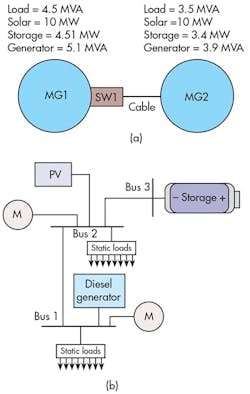Maximizing Power from Solar Panels
Members can download this article in PDF format.
What you’ll learn:
- Unique usage of power with solar photovoltaics.
- Power efficiency assisted via photovoltaics.
Designers may not be fully aware of a very powerful technique that can extract maximum power from solar panels—the double integral sliding mode controller (DISMC).1 This control scheme enables a very effective dynamic sliding switching operation that markedly improves the sliding duty-cycle ratio. This in turn enhances solar-panel efficiency even with partial shading conditions.
In this article, we’ll discuss the sliding duty-cycle ratio effective operation in a DC-DC boost converter.
What’s a Maximum Power Point Tracker?
A maximum power point tracker (MPPT) helps extract maximum power at the maximum power point (MPP) in a photovoltaic system.1 It’s a well-known fact that P-V and I-V properties are nonlinear regarding photovoltaic (PV) cell temperature and solar irradiance.
It’s critical that engineers design and utilize a controller in any PV system to track the MPP. A standalone PV design consists of a solar panel, a load, and a DC-DC converter design with an MPPT controller.
An MPPT based on a sliding mode controller (SMC-MPPT) will have the fundamental strength of tracking control and stability working against uncertainties in a load as well as with internal system parameters. That MPPT enables a high degree of flexibility for design choices and will ease the usage of such hardware as a digital signal processor (DSP), field-programmable gate array (FPGA), and a microcontroller.
Therefore, the SMC-MPPT is free to control nonlinear systems and will include DC-DC converter usage in MPP tracking for PV systems. A caveat here is that the SMC-MPPT method, which is applied to a DC-DC converter, will have some limitations in terms of variable operating frequency, resulting in difficulty of filter circuit design.
The DISMC
In Reference 1 below, an MPPT is proposed with a DISMC concept. This DISMC-MPPT becomes validated with experimental results via the use of a prototype control system setup developed at the Centre of Excellence on Renewable Energy System, NIT Rourkela.
The duty-cycle ratio of the sliding mode control is quite similar to the typical dynamic behavior that leads to enhanced efficiency when compared to various MPPT schemes. A major limitation in the sliding mode control scheme is that it struggles to achieve the steady-state voltage error of the solar panel in the minimum settling-time period.
Enter the concept of the DISMC scheme, which does achieve the effective dynamic sliding switching operation. This effort improves the sliding duty-cycle ratio, thus enhancing solar-panel efficiency during times of partial shading conditions.
An excellent application for the above concepts is the ability to employ the DISMC-MPPT to improve solar-panel efficiency (Fig. 1).4
DISMC-MPPT Applications
Solar cool box for fish storage at sea
Creating a fish-storage work scheme when at sea requires energy obtained in both PV mode and grid mode that will simultaneously supply thermoelectric, liquid flow heat-exchanger systems, and an Arduino control system (Fig. 2).5
Adaptive load-shedding technique for energy management in networked microgrids
The load-shedding algorithm is defined as a set of controls that can remove the electrical loads from the microgrids and force the system to find a new equilibrium point to maintain the voltage within the nominal range.6
This load-shedding scheme is set up in a fully decentralized way with several stages. Each stage features a tripping voltage, time delay, and amount of load shed. The key objective of the load-shedding scheme is to remove a minimum amount of load in the shortest period of time.
A radially connected microgrid cluster, with two microgrids, is derived based on a real distribution system (Fig. 3).
References
1. Raseswari Pradhan and Bidyadhar Subudhi, Senior Member, IEEE, “Double Integral Sliding Mode MPPT Control of a Photovoltaic System.”
2. “A Novel Three-Phase Multi-Objective Unified Power Quality Conditioner,” M-OUPQC.
3. Hasibul Islam Peyal, Electrical & Computer Engineering; Md. Abu Hanif Pramanik, Electrical & Computer Engineering; Subarto Kumar Ghosh, Electrical & Electronic Engineering; and Tushar Kanti Roy, Electronics & Telecommunication Engineering, Rajshahi University of Engineering & Technology, “Design of a Double Integral Sliding Mode Controller for DC-DC Boost Converters in Applications for Fuel Cells.”
4. Immadisetty Rahul and Raju Hariharan, “Enhancement of Solar PV Panel Efficiency Using Double Integral Sliding Mode MPPT Control,” Tsinghua Science and Technology, ISSNll1007-0214 22/22 pp. 271-283, DOI: 10.26599/TST.2023.9010030, Volume 29, Number 1.
5. Rizal Justian Setiawan, Yu-Tzu Chen, and Indra Dwi Suryanto, “Cost-Effective Fish Storage Device for Artisanal Fishing in Indonesia - Utilization of Solar Cool Box,” 2023 IEEE 17th International Conference on Industrial and Information Systems (ICIIS), IEEE.
6. W.E.P. Sampath Ediriweera and N.W.A. Lidula, “Adaptive Load Shedding Technique for Energy Management in Networked Microgrids,” IEEE 2023.
About the Author

Steve Taranovich
Freelance Technical Writer, Phoenix Information Communication LLC
Steve is a contributing editor to Electronic Design.
Author of the non-fiction “Guardians of the Right Stuff,” a true story of the Apollo program as told by NASA and Grumman Corp. engineers, an astronaut, and technicians.
Experienced Editor-In-Chief of EETimes/Planet Analog and Senior Technical Editor at EDN running the Analog and Power Management Design Centers from 2012 to 2019.
A demonstrated history in electronic circuit design and applications for 40 years, and nine years of technical writing and editing in industry. Skilled in Analog Electronics, Space-related Electronics, Audio, RF & Communications, Power Management, Electrical Engineering, and Integrated Circuits (IC).
1972 to 1988 worked as a circuit design engineer in audio (8 years) and microwave (8 years). Then was Corporate Account Manager/applications engineer for Burr-Brown from 1988 to 2000 when TI purchased Burr-Brown. Worked for TI from 2000 to 2011.
Strong media and communication professional with a BEEE from NYU Engineering in 1972 and an MSEE from Polytechnic University in 1989. Senior Lifetime member of IEEE. Former IEEE Long Island, NY Director of Educational Activities. Eta Kappa Nu EE honor society member since 1970.



